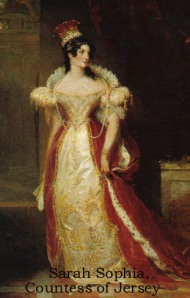Recently I blogged about Debrett’s and Burke’s Peerage and mentioned in an off-the-cuff comment that those Regency mamas tended to stick to the same 15 or 20 Christian names for their children.
This holds particularly true for the aristocracy. The older the aristocratic family, the more they recycled the same names. They still do. The interior designing daughter of the Duke of Marlborough is named Harriet Churchill. Not too many Harriets around these days – unless your father is a duke.
The former Lady Diana Spencer, who became the beloved Princess Diana, was one in a very long line of Lady Diana Spencers.
Even British kings are keen to recycle the same names. Therefore, you’ve got your Jameses, Charleses, Edwards, Georges, Richards, Henrys, to name some of the most prominent.
Earlier in my writing career I was cognizant of my heroes – most of whom were aristocrats – holding proper-sounding Regency first names. I had Charles, James, Thomas, Edward, George, Richard. I batted a thousand.
But I really struck out with my females. After meeting a woman named Glee, I told her I would make that name the heroine in one of my books. So I did. She had a sister named Felicity, and a child named Joy. Oh, boy! Then I threw in a Carlotta, the raven-haired vixen who always wore purple. Guess what? No Regency women had those names. (I got it right in my first two published books – before I strayed.)
The more I’ve studied the Regency, the more offensive it is to me when a fictional heroine or hero bears a decidedly non-Regency name. Especially if the character is an aristocrat. This wasn’t done.
To prove my point, I went on a search of my period Burke’s Peerage. I did digital searches as well as eyeballing about 50 random pages.
It was amazing how much the same names kept popping up. For females, Elizabeth was the most common. There were also many Anns as well as Annes, tons of Harriets, Franceses, Charlottes, Janes and Margarets.
There were variations of Mary which included Marie, Marian and Mary Ann. Dorothy as well as Dorothea were fairly common, as were Catherine, Catharine, and Katherine.
For men, the repetition of a handful of names was even more obvious. James, John, and William win, hands down, as the most common, but there were a lot of males named Thomas, Robert, Richard, Edward, Hugh, Philip, Charles, and Alexander.
Some other popular male names included Arthur, Francis, and David.
Some male names twisted into female names include Frederick/Fredericka, George/Georgiana, and Henry/Henrietta, all of those combinations being very popular in Regency England. More rarely, one could find the Jacob/Jacobina variation or Justin/Justina.
Here are some less common female names in use during the Regency: Abigail, Alice, Agnes, Alicia, Beatrice, Barbara, Caroline, Emma, Emily, Eleanor, Ellen, Hannah, Helen, Isabella, Julia, Joane, Jemima, Louisa, Lavinia, Lydia, Lucy, Letitia, Martha, Rebecca, Sophia, Sarah, Susan, and Teresa.
Less common names for males included Benjamin, Cecil, Christopher, Dudley, Daniel, Edmund, Evan, Henry, Joseph, Lawrence, Michael, Matthew, Miles, Martin, Nicholas, Patrick, Ralph, Reginald and Stephen.
Occasionally, younger sons would be given what I assume to be old family surnames. I found a Willoughby, Albemarle, and Montague.
I recently read a book where the aristocratic hero was named Jared. My search of almost 1,400 pages of the peerage yielded zero males named Jared. I think it’s harder for an author to pull off an out-of-period name for an aristocratic hero because these families abided by an unwritten rule that the heirs would carry on the same old family names.
All of this being said, I must point out that all these names I’ve listed here are for aristocrats. For characters of the lower classes, the rules might change. Most aristocrats were Church of England. Many of the lower classes belonged to evangelical churches and oftentimes would give their children names that might harken back to the Old Testament.
For period authors in doubt, think back to the signers of the American Declaration of Independence. Most of those men descended from British; therefore, their names are spot-on for our period.
And for a hero, you can never go wrong if he bears the name of an English king of the past five or six-hundred years.
Next week’s blog will address Regency surnames. © 2011, Cheryl Bolen
 Many fans of my Brides of Bath series have been emailing me to ask when the fourth and final book of the series will be released. I’m happy to announce the book — now titled TO TAKE THIS LORD — is scheduled to come out Oct. 1. The first three books came out late May and early June and have been very popular.
Many fans of my Brides of Bath series have been emailing me to ask when the fourth and final book of the series will be released. I’m happy to announce the book — now titled TO TAKE THIS LORD — is scheduled to come out Oct. 1. The first three books came out late May and early June and have been very popular.




